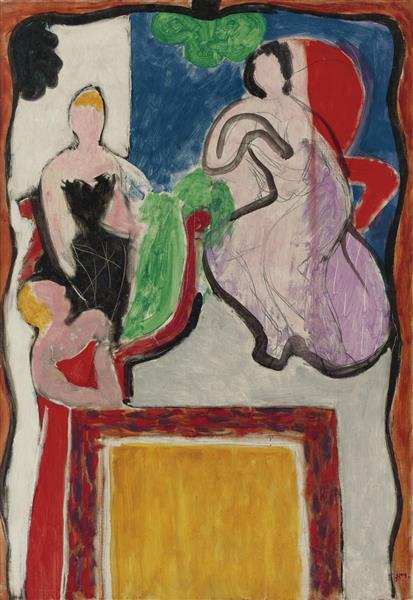Description
In the vast artistic trajectory of Henri Matisse, "Le Chant" (1938) stands as a vivid testament to his incessant quest to capture the essence of the human form and the exaltation of life through color. This work, with its dimensions of 42x60 cm, constitutes a majestic example of how the master of Fauvism manages to interconnect forms and colors to express his artistic and emotional concerns.
Henri Matisse, born in 1869 in Le Cateau-Cambrésis, France, is widely recognized as one of the great innovators of modern art. Throughout his career, Matisse worked tirelessly to distance himself from traditional Impressionism and Realism, developing a distinctive style that celebrated the free expression of color and the simplification of forms. "Le Chant" is a coherent display of this stylistic evolution.
When observing "Le Chant", it is evident that Matisse moves away from detailed representation to focus on a more symbolic and abstract interpretation. The painting shows two female figures seated in a domestic setting, engaged in a silent dialogue or a shared song, as suggested by the title. The composition is notably balanced, with an orderly but flexible structure that allows the figures and decorative elements to coexist in harmonious resonance.
The use of color in "Le Chant" is another manifestation of Matisse's mastery over the palette. The work is imbued with earthy and warm tones, combined with the deep blue of one figure's dress and the vibrant green of the leaves that adorn the space. These colors not only create an atmosphere of intimacy and serenity but also highlight the importance the artist placed on the interaction between light and shadow to create depth without resorting to traditional perspective.
The human figures in the painting are represented with soft, curved lines that denote elegance and femininity. The simplicity of the forms highlights expression and movement, emphasizing the importance of gesture and posture in emotional communication. The women's faces, although simple in detail, convey introspection and a connection that invites the viewer to contemplate the scene beyond the visible.
Besides its undeniable plastic beauty, "Le Chant" reflects Matisse's interest in Mediterranean culture, a recurring influence in his work. The interior clearly evokes typically southern spaces, with the use of tapestries and lush vegetation, elements that recall the luminous and vital environments that so inspired Matisse during his stays in places like Nice.
To fully appreciate "Le Chant", it is crucial to understand it within the series of “dancers” and similar works that Matisse produced during the 1930s, where his focus was on the plastic interaction between color and form, always seeking a synthesis between the ornamental and the natural. This painting, like many of his contemporaries, is a showcase of how Matisse managed to elevate decorative art to a space of deep content and meaning, demonstrating that the pursuit of beauty was also a way to explore and express the complexity of human existence.
In conclusion, "Le Chant" is a work that encapsulates the talent and unique vision of Henri Matisse, his ability to turn the everyday into a spectacle of shapes and colors that speak directly to the soul. It is, ultimately, an invitation to a silent and eternal song, a celebration of life captured in a moment of artistic contemplation.

